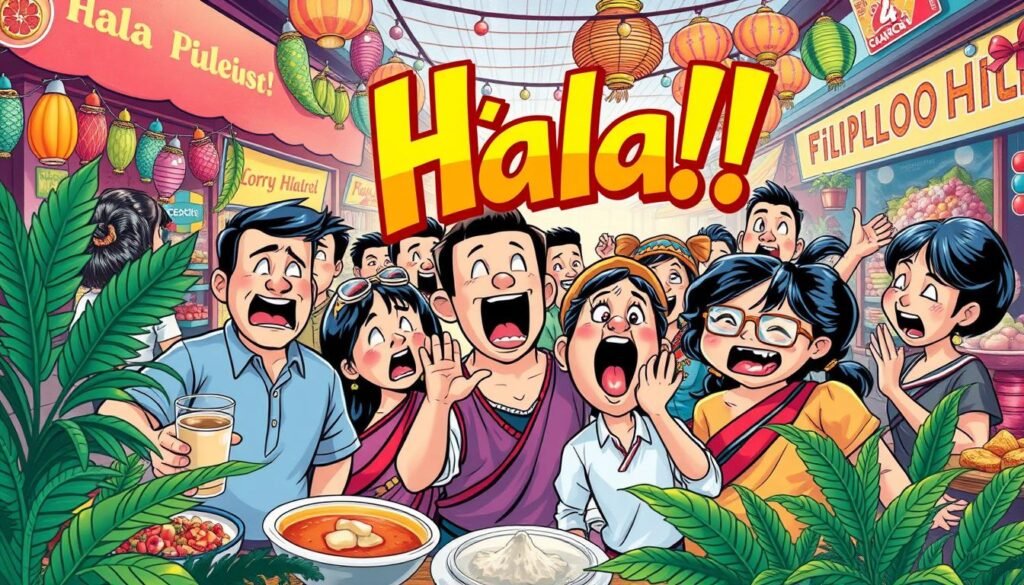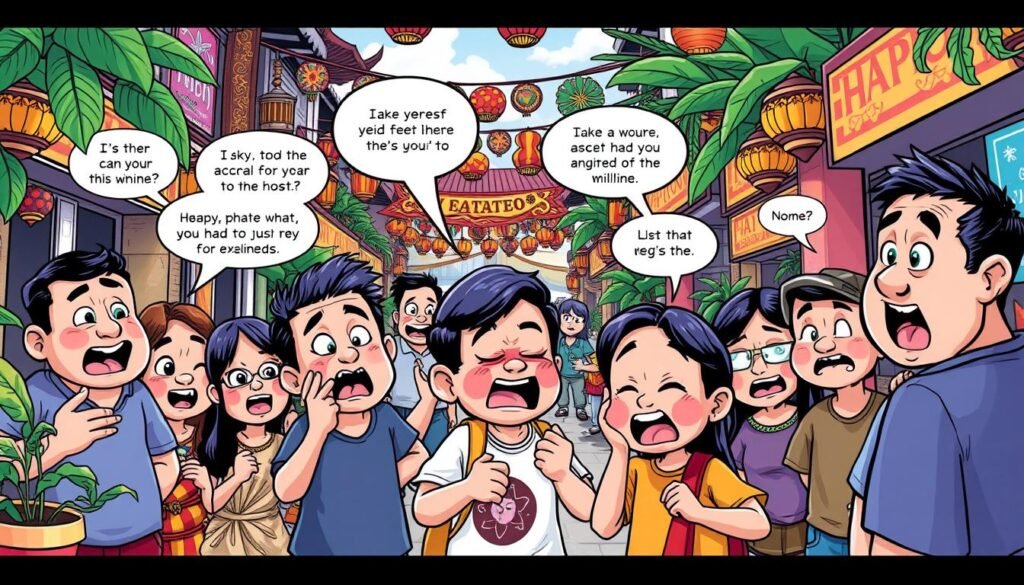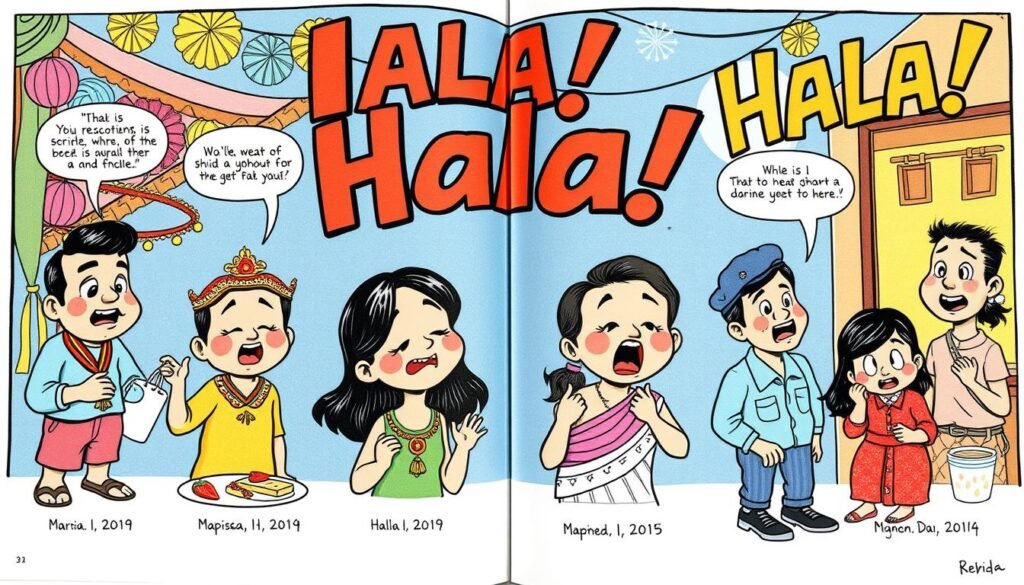What makes a single word or expression so powerful? It can express emotions, build relationships, and shape attitudes. In Filipino culture, “Hala” is more than a word. It’s a key part of communication, studied by researchers.
Exploring “Hala” takes us into its origins, meanings, and uses. From daily talks to online chats, it shows the power of language. Over the last 20 years, research has shown discourse particles like “Hala” play a big role. They help us feel emotions and connect with others.
Key Takeaways
- Discourse particles like “Hala” have numerous micro-functions, including conveying emotions and establishing relationships.
- The study of discourse particles has expanded beyond linguistics into fields like communication and sociology.
- “Hala” is a significant expression in Filipino culture, often used to convey surprise or excitement.
- Research on discourse particles can provide insights into the flow of conversation and how to make it smoother and more engaging.
- Understanding “Hala” and other discourse particles can help non-native speakers connect with Filipino culture and language.
- The use of discourse particles like “Hala” can vary significantly based on conversational context and speaker intentions.
Understanding the Meaning of “Hala”
“Hala” is a common Filipino word that means surprise or shock. It’s used in daily talks to show many feelings, like shock or excitement. In Filipino culture, “Hala” is more than just a word. It shows deep emotions that reflect the Filipino values and relationships.
When someone says “Hala, ang ganda ng view!” (Oh, the view is beautiful!), it shows wonder and amazement. Here, “Hala” means a positive surprise or admiration.
“Hala” can also mean something is urgent or important. For example, “Hala, we need to go now!” shows a need for quick action. In this case, “Hala” grabs attention and stresses the urgency of the situation.
| Expression | Meaning |
|---|---|
| Hala, ang ganda ng view! | Oh, the view is beautiful! |
| Hala, we need to go now! | We need to go now, it’s urgent! |
The Origins of “Hala”
The word “hala” comes from different places. It’s linked to Hawaiian, Proto-Malayo-Polynesian, and Ottoman Turkish. Knowing where it comes from helps us understand its role in Filipino culture.
The word “hala” can mean feeling embarrassed. It also has forms for comparing and showing the most. It comes from Arabic, meaning “yet”, “how”, or “even so”.

To dive deeper into the ancient Filipino script, check out this website. It offers a detailed guide on the subject.
Historical Background
“Hala” has been used in writing for over 300 years. It has grown in popularity over time. In Filipino culture, it’s used to express surprise or caution.
Linguistic Roots
The origins of “hala” are varied. In Hawaiian, it’s pronounced /ha.la/. In Polish, it’s /ˈxa.la/. In Javanese, it carries a darker meaning, linked to “bad” or “evil”. This connects to its Malay root, “bala”, meaning “misfortune”.
“Hala” in Everyday Conversations
In everyday talks, “Hala” is often used as an exclamation to show surprise or hurry. This shows how flexible the Filipino language is. A single word can mean many things.
Using “Hala” in chats can make the conversation more lively or urgent. For instance, saying “Hala, I just saw a great movie!” shows excitement. Saying “Hala, we need to finish this project now!” means it’s very important.
Here are some ways “Hala” is used in daily talks:
- Showing surprise or amazement: “Hala, that’s amazing!”
- Pointing out urgency or importance: “Hala, we need to act now!”
- Emphasizing a point: “Hala, I’m so excited for the weekend!”
Understanding how “Hala” is used in daily chats helps us see the Filipino language’s depth. It’s used for surprise, urgency, or to stress a point. “Hala” is a key word in Filipino communication.
| Context | Example | Meaning |
|---|---|---|
| Surprise | “Hala, I just won a prize!” | Expressing astonishment or shock |
| Urgency | “Hala, we need to finish this now!” | Signaling importance or urgency |
| Emphasis | “Hala, I’m so happy to see you!” | Adding emphasis to a statement |
Different Contexts for Using “Hala”
“Hala” has different uses, from casual chats to formal events. It’s key to understand when and how to use it. This helps us get the full meaning of the language and expression.
In everyday talks, “Hala” shows surprise or excitement. For example, saying “Hala, I just saw a great movie!” shows enthusiasm. In formal situations, it signals something urgent or important. This shows how flexible the expression is.
Using “Hala” to highlight something important is common. Phrases like “Hala, listen to this!” grab attention. This shows how one expression can mean many things in different situations.

| Context | Usage |
|---|---|
| Casual conversations | Expressing surprise or excitement |
| Formal settings | Signaling urgency or importance |
| Calling attention | Emphasizing significance |
The Cultural Significance of “Hala”
The Filipino expression “hala” shows how people interact and connect in the community. It brings out surprise and excitement, often during big events and elections.
In Filipino culture, “hala” is more than words. It represents the community’s values and norms. It helps people communicate and share feelings in a special way.

- Community involvement in elections and festive events
- Importance of kinship ties and social relationships
- Use of humor and creative expressions in communication
“Hala” brings people together, evokes emotions, and fosters a sense of community. It’s a key part of Filipino identity and expression.
Variations of “Hala”
It’s key to know the different forms of “Hala” to fully grasp the language. The Philippines is rich in languages, with each area having its own words and ways of speaking. “Hala” has various forms and similar sayings across the country.
In different places, “Hala” can mean different things. It might show surprise, joy, or even anger. The culture and language of the Philippines shape how “Hala” is used and understood.
Here are some examples of “Hala” variations:
- Regional dialects, like “Hala” in Tagalog and “Hala” in Cebuano
- Similar expressions, such as “Kamusta” or “Ano ba”

These changes show how flexible and diverse the Filipino language is. They also stress the need to understand the cultural and linguistic background of “Hala.”
| Region | Variation of “Hala” |
|---|---|
| Tagalog | Hala |
| Cebuano | Hala |
How “Hala” is Used Online
The online use of “Hala” shows how it has grown as a expression. It’s now used in many digital places. On social media, “Hala” is a way to show surprise or excitement. It lets users share their feelings in a fun and detailed way.
A study found that “Hala” is used more online now. Many people use it in their daily online talks. For example, someone might say “Hala, I just saw the funniest video!” to share their surprise with others.

As online communities keep growing, “Hala” will be key in how we talk online. Learning about “Hala” online helps us understand human communication better. It shows how language changes in the digital world.
Common Misunderstandings about “Hala”
There are often misunderstandings about the Filipino expression “Hala”. These come from misinterpretations and not knowing the cultural nuances. In everyday talk, “Hala” is used as an exclamation to show surprise or urgency.
Some think “Hala” is always negative, but it’s used in many ways. It can be used in both casual and formal talks. Knowing the cultural context is key to avoid confusion.
Here are some common misconceptions about “Hala”:
- Misinterpretation of the expression’s meaning
- Lack of understanding of cultural nuances
- Incorrect usage in different contexts

By knowing these common misunderstandings, we can improve our understanding of “Hala”. We can use it in a way that is respectful and effective.
| Context | Usage |
|---|---|
| Casual talks | Expressing surprise or excitement |
| Formal settings | Signaling urgency or importance |
Alternatives to “Hala”
Exploring alternatives to “Hala” helps us communicate better. It lets us express a wide range of feelings. In Filipino culture, there are many ways to show surprise or excitement.
Some Filipino expressions include:
- Ano ba? (What’s this?) – used to express surprise or shock
- Grabe! (Wow!) – used to express admiration or astonishment
- Talaga? (Really?) – used to express skepticism or surprise
These words can be used in many situations. They add variety to our language. They help us express our feelings more clearly.
It’s important to think about the situation and the feeling you want to share. For example, Grabe! shows deep admiration. Talaga? is a gentle way to question something. Learning these expressions makes us better at sharing our emotions.

| Expression | Meaning | Context |
|---|---|---|
| Ano ba? | What’s this? | Surprise or shock |
| Grabe! | Wow! | Admiration or astonishment |
| Talaga? | Really? | Skepticism or surprise |
The Impact of “Hala” on Filipino Identity
The phrase “Hala” deeply affects Filipino identity, showing the country’s rich culture and language. It captures Filipino values and humor, making it a special part of who Filipinos are.
A study on Filipino culture shows “Hala” is linked to religiosity and the supernatural. This shows how language and expression shape Filipino identity.
Key aspects of Filipino identity shown in “Hala” include:
- Resilience and adaptability
- Community unity and compassion
- A strong sense of humor and creativity

In conclusion, “Hala” has a big impact on Filipino identity. It shows the country’s rich culture and language. By understanding “Hala,” we can see the unique traits of the Filipino identity.
Teaching “Hala” to Non-Native Speakers
Teaching “Hala” to non-native speakers needs a careful plan. It’s important to make the concept simple and give examples of how it’s used. This helps learners understand and use “Hala” correctly.
Start by saying “Hala” is an exclamation for surprise, excitement, or urgency. For example, someone might say “Hala!” when seeing a stunning sunset or getting good news. These examples help learners grasp the emotional side of “Hala” and how to use it naturally.
“Hala” is used in many situations, like watching an exciting movie or playing a fun game. It shows excitement or surprise. Learners can practice using it in these situations. They can also mix “Hala” with other Filipino expressions to make their sentences more interesting.

For more on Filipino culture and language, check out this website. It talks about the history and importance of expressions like “Hala”. Learning about the language and culture helps learners appreciate “Hala” more.
Some important tips for teaching “Hala” include:
- Give clear explanations of what “Hala” means and how it’s used.
- Provide examples of “Hala” in real-life situations.
- Encourage learners to practice using “Hala” in conversations.
- Highlight the role of culture in learning a language.
“Hala” in Filipino Literature and Arts
The use of “Hala” in Filipino literature and arts is quite interesting. It shows how complex the Filipino language is. It can express surprise and emotion well.
In books, “Hala” can mean anything from shock to excitement. It’s often used in conversations to make characters more real.
In songs and movies, “Hala” shows surprise or shock. This shows how important language is in Filipino culture. Words can mean different things depending on the context.
The Filipino language is always changing. It adapts to new ideas and influences.
Here are some examples of “Hala” in Filipino literature and arts:
- In “Noli Me Tangere” by Jose Rizal, “Hala” shows surprise and anger at the Spanish rule.
- In “Hala, Hala” by Eraserheads, “Hala” means excitement and energy.
- In “Hala, Hala, Hala” by Brillante Mendoza, “Hala” shows shock at plot twists.

The use of “Hala” in literature and arts shows the richness of the Filipino language. It shows how it can express complex feelings in a unique way.
| Medium | Example | Usage of “Hala” |
|---|---|---|
| Literature | “Noli Me Tangere” by Jose Rizal | To express surprise and indignation |
| Songs | “Hala, Hala” by Eraserheads | To convey excitement and energy |
| Movies | “Hala, Hala, Hala” by Brillante Mendoza | To express shock and astonishment |
The Evolution of “Hala”
Understanding “Hala” is key to its study. It has changed a lot over time. This expression has been in Filipino culture for centuries. Its meaning has been shaped by social, cultural, and technological changes.
“Hala” is used to show surprise, excitement, or shock. Its use has changed to meet the needs of Filipinos.
The history of “Hala” is complex. It comes from the country’s rich cultural heritage. To learn more about “Hala” and other Filipino expressions, visit this resource.
Some key aspects of “Hala” include:
- Changes in usage over time, reflecting the dynamic nature of the Filipino language and culture
- Modern adaptations, such as the use of “Hala” in social media and online platforms
- The influence of social, cultural, and technological factors on the meaning and usage of “Hala”

Studying “Hala” is about understanding its meaning and cultural significance. By looking at its evolution, we can learn more about the Filipino language and culture.
| Aspect | Description |
|---|---|
| Changes in usage | Reflecting the dynamic nature of the Filipino language and culture |
| Modern adaptations | Use of “Hala” in social media and online platforms |
| Influence of social, cultural, and technological factors | Shaping the meaning and usage of “Hala” over time |
Learning More about Filipino Expressions
If you want to learn about Filipino expressions, there are many resources out there. You can start with language learning materials like textbooks and online courses. These can help you understand the language and its subtleties. Cultural institutions, such as museums and cultural centers, also offer valuable insights into the history and context of Filipino expression.
To dive deeper into Filipino expressions, check out the blog post on Filipinisms in call centers. It gives a good overview of common expressions used in the field. You can also try language learning apps like the Ling app, which teaches Tagalog and other Filipino languages.
Here are some top resources for learning Filipino expressions:
- Language exchange programs
- Cultural immersion experiences
- Online language courses
By using these resources, you can better understand Filipino language and expression. This will help you communicate more effectively with Filipino colleagues and friends.

Engaging with Filipinos: Using “Hala”
When you talk to Filipinos, saying “hala” can be a fun way to connect. This word is like a bridge between different cultures. It lets people who don’t speak Filipino show surprise and excitement in a way that feels right.
Using “hala” shows you’re interested in how Filipinos speak. It’s a small step that can lead to deeper conversations. By mastering “hala,” you can join in on the fun of Filipino culture. You’ll feel like you belong.
FAQ
What is the meaning and importance of the term “Hala” in Filipino culture?
“Hala” is a common phrase in Filipino language. It means surprise, shock, or urgency. It shows the values and social interactions of Filipinos.
What is the literal translation and emotional context of “Hala”?
The meaning of “Hala” can vary. It’s often used to show surprise. But it can also mean concern, worry, or alarm.
What is the historical background and linguistic origins of the term “Hala”?
“Hala” comes from the Philippines’ diverse languages. It was shaped by indigenous, Spanish, and American cultures. These influences helped form the Filipino language and “Hala”.
How is “Hala” used in everyday conversations among Filipinos?
“Hala” is used daily to show surprise or urgency. It changes the conversation’s tone. It shows the expressive nature of Filipino communication.
In what different contexts is “Hala” used?
“Hala” is used in many situations. It can call attention, express feelings, or react to surprises. Its meaning changes based on the situation.
What is the cultural significance of “Hala” in the Filipino community?
“Hala” is key in Filipino culture. It shows the community’s values, emotions, and communication. It’s part of their cultural identity.
What are the variations of “Hala” and how do they reflect the linguistic diversity of the Philippines?
The Philippines has many languages, and “Hala” shows this diversity. Different dialects and expressions are used. This richness shows the adaptability of Filipino language.
How is “Hala” used in online and digital contexts?
“Hala” is used online, in social media and memes. It shows how “Hala” has evolved for modern communication.
What are some common misunderstandings about the meaning and use of “Hala”?
Non-native speakers might misunderstand “Hala”. Its meaning is rooted in Filipino culture. Knowing this is key for effective communication.
What are some alternatives to “Hala” and when should they be used?
There are other Filipino expressions like “Hala”. Knowing when to use them can improve communication and understanding.
How does “Hala” contribute to Filipino identity and cultural values?
“Hala” reflects Filipino identity, values, and humor. It shows the essence of Filipino culture and shapes their collective identity.
How can non-native speakers effectively learn and use “Hala” in their interactions with Filipinos?
Teaching “Hala” to non-native speakers is important. Focus on simplifying it, using examples, and understanding cultural nuances. This helps in effective communication with Filipinos.
How is “Hala” represented in Filipino literature, arts, and popular culture?
“Hala” is featured in Filipino literature, arts, and culture. It expresses emotions and cultural values. Its presence in these areas shows its lasting impact on Filipino culture.
How has “Hala” evolved over time, and what are some of the modern adaptations of this expression?
“Hala” has changed over time, reflecting Filipino culture’s evolution. Understanding these changes shows “Hala”‘s ongoing importance in Filipino society.
What resources are available for learning more about Filipino expressions like “Hala”?
Many resources exist for learning about Filipino expressions. Language materials, cultural institutions, and online communities can enhance understanding and appreciation of Filipino language and culture.
How can using “Hala” and other Filipino expressions help engage with the Filipino community?
Using “Hala” and other expressions can connect with the Filipino community. It encourages conversation, builds connections, and shows interest in Filipino culture. This promotes intercultural exchange and respect.
Source Links
- Microsoft Word – 1.11545(pp.1-19).docx – https://files.eric.ed.gov/fulltext/ED573079.pdf
- Hala, Hālā, Hāla, Halā: 34 definitions – https://www.wisdomlib.org/definition/hala
- Hala – https://toknowtheking.weebly.com/moments/hala
- Hala Meaning, Origin, History, And Popularity – https://www.momjunction.com/baby-names/hala/
- hala – Wiktionary, the free dictionary – https://en.wiktionary.org/wiki/hala
- Young and Profiting (YAP) with Hala Taha – https://podcasts.apple.com/my/podcast/young-and-profiting-yap-with-hala-taha/id1368888880
- No title found – https://blog.westminster.ac.uk/graduateschoolfestival/in-conversation-with-hala-alnaji-and-olivia-sparkhall/
- Why Hala For Your Business? – https://medium.com/@halamessage/why-hala-for-your-business-ff010be34c83
- 🆚What is the difference between "hiç, asla, hala" and "in the “never” context." ? "hiç, asla, hala" vs "in the “never” context." ? – https://hinative.com/questions/24230419
- Hala Systems and Planet: A Partnership for Civilian Protecti… – https://www.planet.com/pulse/hala-systems-and-planet-a-partnership-for-civilian-protection/
- Verifiable Compute and Hala – https://www.eqtylab.io/blog/verifiable-compute-and-hala
- Hala bira! Halalan! Cultural Lessons from Philippine Elections – Department of Anthropology – https://anthro.upd.edu.ph/hala-bira-halalan-cultural-lessons-from-philippine-elections/
- Mālama Lauhala: Caring for the Cultural Resource of Hala at Niuliʻi, Kohala – https://historichawaii.org/2024/06/14/malamahalakohala/
- Hala Fruit – https://specialtyproduce.com/produce/Hala_Fruit_22754.php
- Bishop Museum – Ethnobotany Database – http://data.bishopmuseum.org/ethnobotanydb/ethnobotany.php?b=d&ID=hala
- Pandanus tectorius (Hala) – http://www2.hawaii.edu/~eherring/hawnprop/pan-tect.htm
- Pandanus tectorius | Plant Pono – https://plantpono.org/pono-plants/pandanus-tectorius-hala/
- Hala Business – Apps on Google Play – https://play.google.com/store/apps/details?id=sa.halalah.business
- “Hala” and an experience of a Brown body – https://medium.com/paragraphpalace/hala-and-the-experience-of-a-brown-body-51755e4befeb
- Review: ‘Hala’ is Precious and Poignant, a Coming-of-Age Story That Considers the Humanity of Making Mistakes – https://www.pajiba.com/film_reviews/review-hala-on-apple-tv-is-precious-and-poignant.php
- Hala – https://digitalcommons.unomaha.edu/cgi/viewcontent.cgi?article=2038&context=jrf
- Hala – Company Profile – Tracxn – https://tracxn.com/d/companies/hala/__H5P9mWiZscB4SoM7uxuyA50Ou8_v7lMgLlDyK2Lpid4/competitors
- Best Hala.ai Alternatives – 2025 | Product Hunt – https://www.producthunt.com/products/hala-ai/alternatives
- Hala Similar Movies • FlixPatrol – https://flixpatrol.com/title/hala/similar-movies/
- ONLY IN THE PHILIPPINES – Google Arts & Culture – https://artsandculture.google.com/story/only-in-the-philippines-center-for-art-new-ventures-sustainable-development-canvas/zgXRkeopr5qoJQ?hl=en
- PDF – https://journals.upd.edu.ph/index.php/rws/article/download/3527/3260
- PDF – https://pssc.org.ph/wp-content/pssc-archives/Philippine Sociological Review/1966/Num 1/05_The Filipino Mental Make-up and Science.pdf
- Ya Hala- Arabic For Non Native Speaker Textbook: Level 1, Part 1 – https://tajoora.co.uk/products/ya-hala-arabic-for-non-native-speaker-textbook-level-1-part-1
- Teaching English Idioms to L2 Learners: ESL Teachers’ Perspective – https://repository.stcloudstate.edu/context/engl_etds/article/1018/viewcontent/T___Rizq.pdf
- Five Things Non-Filipino Spouses Say in Tagalog – Cold Tea Collective – https://coldteacollective.com/five-things-non-filipino-spouses-say-in-tagalog/
- Bathala – https://en.wikipedia.org/wiki/Bathala
- Hala (Planet) – https://marvel.fandom.com/wiki/Hala_(Planet)
- Enhancement and Evolutionary Mechanism of Ethnic Rural Tourism Resilience Based on the Actor Network Theory: A Case Study of Hala New Village in Northeast China – https://www.mdpi.com/2071-1050/17/1/278
- HALA KA! – VeritasPH – https://www.veritasph.net/hala-ka/
- Tagalog Expressions: 16 Easy Terms You Should Know – ling-app.com – https://ling-app.com/fil/tagalog-expressions/
- HISTORY – https://jalajala.gov.ph/history/
- From the Streets to the Screens, Foreigners and Homesick Pinoys go “Hala Bira” in Online Fiesta – – https://balikbayanmagazine.com/arts-culture/from-the-streets-to-the-screens-foreigners-and-homesick-pinoys-go-hala-bira-in-online-fiesta/
- PPO STAGES OUTREACH CONCERT IN KALIBO – Cultural Center of the Philippines – https://culturalcenter.gov.ph/press-release/ppo-stages-outreach-concert-in-kalibo/

